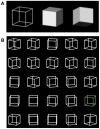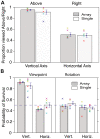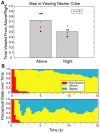Asymmetries in perception of 3D orientation
- PMID: 20209050
- PMCID: PMC2832009
- DOI: 10.1371/journal.pone.0009553
Asymmetries in perception of 3D orientation
Abstract
Visual scene interpretation depends on assumptions based on the statistical regularities of the world. People have some preference for seeing ambiguously oriented objects (Necker cubes) as if tilted down or viewed from above. This bias is a near certainty in the first instant (approximately 1 s) of viewing and declines over the course of many seconds. In addition, we found that there is modulation of perceived orientation that varies with position--for example objects on the left are more likely to be interpreted as viewed from the right. Therefore there is both a viewed-from-above prior and a scene position-dependent modulation of perceived 3-D orientation. These results are consistent with the idea that ambiguously oriented objects are initially assigned an orientation consistent with our experience of an asymmetric world in which objects most probably sit on surfaces below eye level.
Conflict of interest statement
Figures




Similar articles
-
Eye movements during the viewing of Necker cubes.Perception. 1978;7(5):575-81. doi: 10.1068/p070575. Perception. 1978. PMID: 733448
-
Rotation of objects in pictures viewed at an angle: evidence for different properties of two types of pictorial space.J Exp Psychol Hum Percept Perform. 1979 Feb;5(1):78-87. doi: 10.1037//0096-1523.5.1.78. J Exp Psychol Hum Percept Perform. 1979. PMID: 528932
-
Geometric transformations of pictured space.Perception. 1978;7(3):269-82. doi: 10.1068/p070269. Perception. 1978. PMID: 693227
-
Visual perception and the statistical properties of natural scenes.Annu Rev Psychol. 2008;59:167-92. doi: 10.1146/annurev.psych.58.110405.085632. Annu Rev Psychol. 2008. PMID: 17705683 Review.
-
Vision: the world through picket fences.Curr Biol. 2004 May 25;14(10):R381-2. doi: 10.1016/j.cub.2004.05.011. Curr Biol. 2004. PMID: 15186762 Review.
Cited by
-
Divergent mechanisms of perceptual reversals in spinning and wobbling structure-from-motion stimuli.PLoS One. 2024 Feb 21;19(2):e0297963. doi: 10.1371/journal.pone.0297963. eCollection 2024. PLoS One. 2024. PMID: 38381707 Free PMC article.
-
The interaction of perceptual biases in bistable perception.Sci Rep. 2017 Feb 6;7:42018. doi: 10.1038/srep42018. Sci Rep. 2017. PMID: 28165061 Free PMC article.
-
Positive and negative hysteresis effects for the perception of geometric and emotional ambiguities.PLoS One. 2018 Sep 26;13(9):e0202398. doi: 10.1371/journal.pone.0202398. eCollection 2018. PLoS One. 2018. PMID: 30256789 Free PMC article. Clinical Trial.
-
Circular inference in bistable perception.J Vis. 2020 Apr 9;20(4):12. doi: 10.1167/jov.20.4.12. J Vis. 2020. PMID: 32315404 Free PMC article.
-
A different view on the Necker cube-Differences in multistable perception dynamics between Asperger and non-Asperger observers.PLoS One. 2017 Dec 15;12(12):e0189197. doi: 10.1371/journal.pone.0189197. eCollection 2017. PLoS One. 2017. PMID: 29244813 Free PMC article.
References
-
- Ramachandran VS. Perception of Shape From Shading. Nature. 1988;331:163–166. - PubMed
-
- Nakayama K, Shimojo S. Experiencing and Perceiving Visible Surfaces. Science. 1992;257:1357–1363. - PubMed
-
- Freeman WT. The Generic Viewpoint Assumption in a Framework for Visual Perception. Nature. 1994;368:542–545. - PubMed
-
- Kauffman L. New York: Oxford U. Press; 1975. Sight and Mind.580
-
- Orbach J, Erlich D, Vainstein E. Reversibility of the Necker Cube: III. Effects of Interpolation on Reversal Rate of the Cube Presented Repetitively. Perceptual and Motor Skills. 1963;17:571–582. - PubMed
Publication types
MeSH terms
Grants and funding
LinkOut - more resources
Full Text Sources

